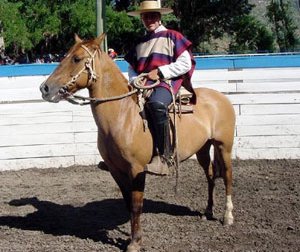|
Home Horse Breeds | First Posted: June 24,2009 May 13, 2020 | |
Chilean Corralero 
The Chilean Corralero has its origins in the Spanish horse. Spanish horses arrived with the Spanish conqueror Pedro de Valdivia (1541). These horses were obtained from southern Peru (they arrived there with Francisico Pizarro in 1514). In 1557 Garcia Hurtado de Mendoza, the new governor, arrived in Chile with 42 horses of the famous caste of the Guzmanes and Valenzuelas, marking the beginning of the Chilean horse breed. A pure Chilean breed appeared by the beginning of the 19th century, and the Chilean Corralero appeared by the end of the 19th century. The Chilean horse or Chilean Corralero is a horse breed from South America. It is the oldest registered native American breed, the oldest registered breed of Iberian origin, the oldest registered horse breed in South America and the oldest registered stock horse breed in the Western Hemisphere. History As in many places of the world, in Chile the horse is a work animal. First it was used by Spanish conquerors for war and for agriculture. When Chile got its independence, the horse was a indispensable partner and used daily; in war for the Army, in the plantations for the countryman and for transportation for everybody. The Chilean Corralero has its major ties in use for working cattle and is now used heavily in Chilean rodeo, which had its origins in the countryside as a game of chasing cattle. It is in this modern event that the Chilean Corralero shows all of its abilities. All these characteristics and the ones listed below make it possible for an 815 pound horse to stop and press a 1100 pound bull.Physical Description and Characteristics
"...Chilean Horses were selected for lateral dexterity, courage to confront and pin belligerent cattle and an even temperament that permitted a high degree of trainability while conserving needed energy for a long day's work. By the 18th century, the yearly round-ups that had been required by decree since 1557 took on massive dimensions. The pens that received cattle herded down from the mountainous terrain needed to have a capacity of no less than 7,000 head. Sorting the cattle by ownership, designated use, and requirements for castration and branding resulted in herding and pushing cattle down long alleyways into classifying pens. This gave rise to the aptitudes now used in the modern-day Chilean rodeo that are performed in a crescent-shaped arena known as a medialuna (half-moon arena). ..." "...Ever since the beginning of the 20th century, the sport of rodeo has become bigger and more organized. Meanwhile the qualities required to excel in this sport were increasingly implanted in the breeding of the Chilean Horse. Nothing has assured the purity of this breed more than its specialization in a sport for which it has been exclusively selected for over 150 years. Outcrossing to other breeds has never been a temptation since the Chilean Horse is well-suited for the Chilean rodeo sport. ..." Note: "The Chilean horse prior to 1850 was a closed breed type, due the absence of European breeds in a country that was convinced they had the best horses in South America. The isolation that resulted from the geographical definition of its borders also made imports less probable. When modern transport made new breeds more accessible, Chile was one of the last places in South America to see them arrive. Even so, the innumerable mountains, ridges and valleys over a 4,300 km (2,700 mi) long landscape assured that the purity of many Chilean Horses remained intact. Faithful traditional breeders also were critical contributors to breed purity by not succumbing to the temptations of cross-breeding. The critical period that popularized the use of other breeds was shortened even more when Chile became the first country to register their national breed. The real stroke of genius was formalizing and popularising a sport where no other breed could be its equal. ... ...To this day, speed rather than endurance is the criteria by which huasos (Chilean cowboys) value their horses. Although the registry was established in an effort to protect a 'national treasure' that was being endangered by the cross-breeding promoted by American enchantment with anything European, the Chilean Horse already had more than a century of selection along specific family lines." The Chilean Horse is not just the oldest stock horse breed in America, but is also is the only stock horse breed that has maintained a closed registry since its inception. For More Information: The Chilean Horse |